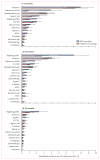Use of quantitative molecular diagnostic methods to identify causes of diarrhoea in children: a reanalysis of the GEMS case-control study
- PMID: 27673470
- PMCID: PMC5471845
- DOI: 10.1016/S0140-6736(16)31529-X
Use of quantitative molecular diagnostic methods to identify causes of diarrhoea in children: a reanalysis of the GEMS case-control study
Abstract
Background: Diarrhoea is the second leading cause of mortality in children worldwide, but establishing the cause can be complicated by diverse diagnostic approaches and varying test characteristics. We used quantitative molecular diagnostic methods to reassess causes of diarrhoea in the Global Enteric Multicenter Study (GEMS).
Methods: GEMS was a study of moderate to severe diarrhoea in children younger than 5 years in Africa and Asia. We used quantitative real-time PCR (qPCR) to test for 32 enteropathogens in stool samples from cases and matched asymptomatic controls from GEMS, and compared pathogen-specific attributable incidences with those found with the original GEMS microbiological methods, including culture, EIA, and reverse-transcriptase PCR. We calculated revised pathogen-specific burdens of disease and assessed causes in individual children.
Findings: We analysed 5304 sample pairs. For most pathogens, incidence was greater with qPCR than with the original methods, particularly for adenovirus 40/41 (around five times), Shigella spp or enteroinvasive Escherichia coli (EIEC) and Campylobactor jejuni o C coli (around two times), and heat-stable enterotoxin-producing E coli ([ST-ETEC] around 1·5 times). The six most attributable pathogens became, in descending order, Shigella spp, rotavirus, adenovirus 40/41, ST-ETEC, Cryptosporidium spp, and Campylobacter spp. Pathogen-attributable diarrhoeal burden was 89·3% (95% CI 83·2-96·0) at the population level, compared with 51·5% (48·0-55·0) in the original GEMS analysis. The top six pathogens accounted for 77·8% (74·6-80·9) of all attributable diarrhoea. With use of model-derived quantitative cutoffs to assess individual diarrhoeal cases, 2254 (42·5%) of 5304 cases had one diarrhoea-associated pathogen detected and 2063 (38·9%) had two or more, with Shigella spp and rotavirus being the pathogens most strongly associated with diarrhoea in children with mixed infections.
Interpretation: A quantitative molecular diagnostic approach improved population-level and case-level characterisation of the causes of diarrhoea and indicated a high burden of disease associated with six pathogens, for which targeted treatment should be prioritised.
Funding: Bill & Melinda Gates Foundation.
Copyright © 2016 Elsevier Ltd. All rights reserved.
Conflict of interest statement
Figures




Comment in
-
GEMS extend understanding of childhood diarrhoea.Lancet. 2016 Sep 24;388(10051):1252-4. doi: 10.1016/S0140-6736(16)31664-6. Lancet. 2016. PMID: 27673454 No abstract available.
References
-
- Liu L, Johnson HL, Cousens S, et al. Global, regional, and national causes of child mortality: an updated systematic analysis for 2010 with time trends since 2000. Lancet. 2012;379:2151–61. - PubMed
Publication types
MeSH terms
Grants and funding
LinkOut - more resources
Full Text Sources
Other Literature Sources
Medical
Molecular Biology Databases
Miscellaneous

